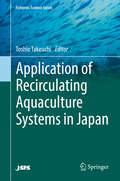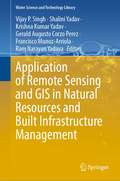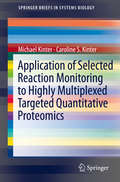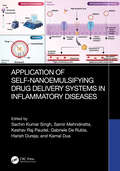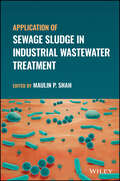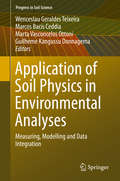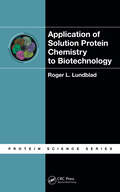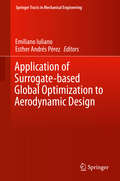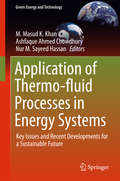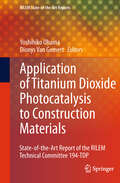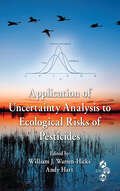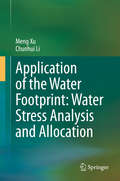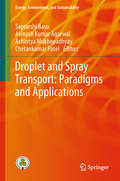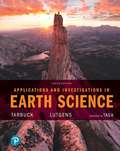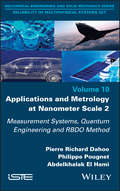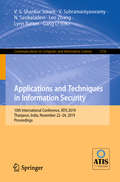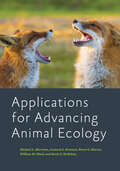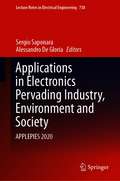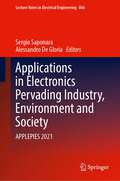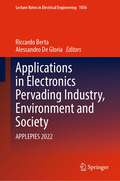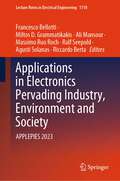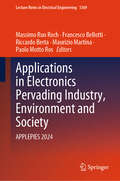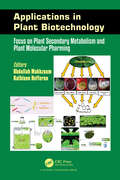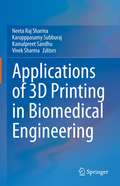- Table View
- List View
Application of Recirculating Aquaculture Systems in Japan (Fisheries Science Series)
by Toshio TakeuchiThis is the first English book to address the current development of closed recirculating aquaculture systems (cRASs) in Japan, and its implications for industry in the near future. It offers an introduction to the topic and discusses the industrial application of cRASs. Around Europe, cRASs using freshwater have been developed, but to date there is little information about cRASs using the saltwater. As such, the book introduces the technical development of cRASs using the saltwater in Japan and describes measures necessary for their industrialization. It also discusses in detail various species, e. g. , flounder, pejerrey, kuruma shrimp, white shrimp and abalone, which have been raised in cRASs. Furthermore, it presents wide topics concerning the technological development of aquariums, an area in which progressive Japanese techniques dominate. Lastly, the book also examines CERAS and poly-culture in Japan. The book is a valuable resource for a wide readership, such as local government officers, energy-industry staff, maintenance and system engineers, as well as those from the construction, agriculture and fishery industries.
Application of Remote Sensing and GIS in Natural Resources and Built Infrastructure Management (Water Science and Technology Library #105)
by Vijay P. Singh Shalini Yadav Ram Narayan Yadava Krishna Kumar Yadav Gerald Augusto Corzo Perez Francisco Muñoz-ArriolaThis book discusses the problems in planning, building, and management strategies in the wake of application and expansion of remote sensing and GIS products in natural resources and infrastructure management. The book suggests proactive solutions to problems of natural resources and infrastructure management, providing alternatives for strategic planning, effective delivery, and growth perspectives. The uniqueness of the book is its broader spectrum of coverage with related interconnections and interdependences across science, engineering, and innovation. The book contains information that can be downscaled to the local level. Presenting a wide spectrum of viewpoints and approaches, the book is a collective of topics such as application to agriculture and forestry (land and landscape, agriculture, forestry management and deforestation), water resources and ecology (hydro-meteorological, climate diagnostics, and prognostics, water resources management, environment management, cross-scale ecology and resilience), urban management (urban planning, design, construction and operations of infrastructure, natural disasters, novel approaches to upgrade old infrastructure), hydro informatics, predictive and geospatial data analytics, synthesis, and management through the various processes, tools, and technologies.
Application of Selected Reaction Monitoring to Highly Multiplexed Targeted Quantitative Proteomics: A Replacement for Western Blot Analysis (SpringerBriefs in Systems Biology)
by Michael Kinter Caroline S. KinterA key experiment in biomedical research is monitoring the expression of different proteins in order to detect changes that occur in biological systems under different experimental conditions. The method that is most widely used is the Western blot analysis. While Western blot is a workhorse in laboratories studying protein expression and has several advantages, it also has a number of significant limitations. In particular, the method is semi-quantitative with limited dynamic range. Western blot focuses on a single protein per sample with only a small number of representative samples analyzed in an experiment. New quantitative tools have been needed for some time to at least supplement, & possibly replace, the Western blot. Mass spectrometric methods have begun to compete with Western blot for routine quantitative analyses of proteins. One of these methods is based on the tandem mass spectrometry technique of selected reaction monitoring (SRM), which is also called multiple reaction monitoring (MRM). Selected reaction monitoring is actually an older tandem mass spectrometry technique, first described in the late 70s, that is widely utilized in the quantitative analysis of small molecules like drugs & metabolites. The use of selected reaction monitoring for the quantitative analysis of proteins has a number of advantages. Most importantly, it is fundamentally quantitative with a wide dynamic range. The output of the analysis is a numerical result that can range over several orders of magnitude. Other advantages include sufficient specificity & sensitivity to detect low abundance proteins in complex mixtures. Finally, selected reaction monitoring can be multiplexed to allow the quantitative analysis of relatively large numbers of proteins in a single sample in a single experiment. This Brief will explain both the theoretical & experimental details of the selected reaction monitoring experiment as it is applied to proteins.
Application of Self-Nanoemulsifying Drug Delivery Systems in Inflammatory Diseases
by Kamal Dua Harish Dureja Keshav Raj Paudel Sachin Kumar Singh Samir Mehndiratta Gabriele De RubisThis book discusses the potential application of self-nanoemulsifying drug delivery systems (SNEDDS) in different inflammatory diseases. It introduces the fundamental principles of SNEDDS, their formulation components, and characterization techniques, providing insights into their mechanisms of drug delivery and formulation optimization. The book also explores the potential of various combination therapies with SNEDDS, highlighting strategies, synergistic effects, and challenges. Furthermore, the chapters in the book highlight the applications of SNEDDS in specific inflammatory diseases, including diabetes, brain diseases, colorectal diseases, cardiovascular diseases, lung diseases, and cancer. Towards the end, the book evaluates the potential toxic effects of SNEDDS components and addresses safety considerations, regulatory aspects, patents, and clinical trials pertaining to SNEDDS. This book is intended for researchers, pharmacologists, pharmaceutical scientists, and clinicians involved in drug delivery and nanomedicine.
Application of Sewage Sludge in Industrial Wastewater Treatment
by Maulin P. ShahAPPLICATION OF SEWAGE SLUDGE IN INDUSTRIAL WASTEWATER TREATMENT Comprehensive reference examining activated sludge technologies in industrial wastewater treatment, combining a theoretical framework with practical methodologies Application of Sewage Sludge in Industrial Wastewater Treatment provides a roadmap to the methodologies for the treatment of industrial wastewaters from several major sectors integrating theory and practice, highlighting the importance of sewage sludge technologies in industrial wastewater treatment to clean up the environment from pollution caused by human activities, and assessing the applications of several existing activated sludge techniques and introduces new emerging technologies. All discussion within the text is based on a solid theoretical background. Application of Sewage Sludge in Industrial Wastewater Treatment covers key topics such as: Issues related to activated sludge treatment, such as biodegradability-based characterization, modelling, assessment of stoichiometric, and kinetic parameters and design Issues related to industrial pollution control, such as in-plant control, effect of pretreatment, and more Recently increasing quantity and complexity of toxic effluents, which can be bio remediable for plants and suitable microbes, whether natural or customized for specific purposes Ecological, profitable, and natural solutions designed to eliminate heavy metals, radionuclides, xenobiotic compounds, organic waste, pesticides, and more This reference provides an essential, one-of-a-kind, integrated approach for environmental microbiologists, biochemical engineers, environmental engineers, effluent treatment plant operators, and biologists and chemists at wastewater treatment plants.
Application of Soil Physics in Environmental Analyses: Measuring, Modelling and Data Integration (Progress in Soil Science)
by Wenceslau Geraldes Teixeira Marcos Bacis Ceddia Marta Vasconcelos Ottoni Guilheme Kangussu DonnagemaThe importance to preserve soil and water have is increasingly recognized. Agricultural practices and ecological trends both affect and are affected by soil physical properties. The more frequency of natural disasters, as landslides and thunderstorms addresses the importance to integrate soil characteristics in predictive models. Soil physics research has grown considerably specially in the use of innovative sensors, soil databases, and modeling techniques have been introduced into soil water relationship and environmental monitoring. Those advances are thoroughly dispersed in articles and conference proceedings In this volume, the authors will bring together the effectiveness of many new field and lab sensors and examine the current state-of-the-art in modeling and data analysis. It also includes innovative approaches and case studies in tropical soils. Future directions in soil physics research are given by key researchers in this discipline.
Application of Solution Protein Chemistry to Biotechnology (Protein Science)
by Roger L. LundbladReflecting the versatility of the author's science and the depth of his experience, Application of Solution Protein Chemistry to Biotechnology explores key contributions that protein scientists can make in the development of products that are both important and commercially viable, and provides them with tools and information required for successfu
Application of Surrogate-based Global Optimization to Aerodynamic Design (Springer Tracts in Mechanical Engineering)
by Emiliano Iuliano Esther Andrés PérezAerodynamic design, like many other engineering applications, is increasingly relying on computational power. The growing need for multi-disciplinarity and high fidelity in design optimization for industrial applications requires a huge number of repeated simulations in order to find an optimal design candidate. The main drawback is that each simulation can be computationally expensive - this becomes an even bigger issue when used within parametric studies, automated search or optimization loops, which typically may require thousands of analysis evaluations. The core issue of a design-optimization problem is the search process involved. However, when facing complex problems, the high-dimensionality of the design space and the high-multi-modality of the target functions cannot be tackled with standard techniques. In recent years, global optimization using meta-models has been widely applied to design exploration in order to rapidly investigate the design space and find sub-optimal solutions. Indeed, surrogate and reduced-order models can provide a valuable alternative at a much lower computational cost. In this context, this volume offers advanced surrogate modeling applications and optimization techniques featuring reasonable computational resources. It also discusses basic theory concepts and their application to aerodynamic design cases. It is aimed at researchers and engineers who deal with complex aerodynamic design problems on a daily basis and employ expensive simulations to solve them.
Application of Thermo-fluid Processes in Energy Systems: Key Issues and Recent Developments for a Sustainable Future (Green Energy and Technology)
by M. Masud K. Khan Ashfaque Ahmed Chowdhury Nur M. Sayeed HassanThis book provides essential information on and case studies in the fields of energy technology, clean energy, energy efficiency, sustainability and the environment relevant to academics, researchers, practicing engineers, technologists and students. The individual chapters present cutting-edge research on key issues and recent developments in thermo-fluid processes, including but not limited to: energy technologies in process industries, applications of thermo-fluid processes in mining industries, applications of electrostatic precipitators in thermal power plants, biofuels, energy efficiency in building systems, etc. Helping readers develop an intuitive understanding of the relevant concepts in and solutions for achieving sustainability in medium and large-scale industries, the book offers a valuable resource for undergraduate, honors and postgraduate research students in the field of thermo-fluid engineering.
Application of Titanium Dioxide Photocatalysis to Construction Materials: State-of-the-Art Report of the RILEM Technical Committee 194-TDP (RILEM State-of-the-Art Reports #5)
by Dionys Van Gemert Yoshihiko OhamaTitanium dioxide photocatalysis is based on the semiconducting nature of its anatase crystal type. Construction materials with titanium photocatalyst show performances of air purification, self-cleaning, water purification, antibacterial action. This book describes principles of titanium dioxide photocatalysis, its applications to cementitious and noncementitious materials, as well as an overview of standardization of testing methods.
Application of Uncertainty Analysis to Ecological Risks of Pesticides
by William J. Warren-Hicks Andy HartWhile current methods used in ecological risk assessments for pesticides are largely deterministic, probabilistic methods that aim to quantify variability and uncertainty in exposure and effects are attracting growing interest from industries and governments. Probabilistic methods offer more realistic and meaningful estimates of risk and hence, pot
Application of the Water Footprint: Water Stress Analysis and Allocation
by Chunhui Li Meng XuBased on the water footprint (WF) concept, this book reviews WF-based water stress evaluation methods at the city, provincial and river basin levels respectively. In addition, it explores the factors that influence regional water footprint in the spatial sequence via the extended STIRPAT model. Highlighting the utilization of WF accounting in sustainable water management, one of the book’s goals is to establish the optimization model of water allocation in various industrial sectors. Based on WF accounting, which thoroughly considers the water input for production, the relevant intermediate water inputs, and the water amount for wastewater discharge dilutions, the book provides a wealth of insights for scholars and practitioners with an interest in water resources and environmental management. In addition, it exhibits a scientific plan for regional water resource utilization and allocation, helping relieve regional water shortages.
Applications Paradigms of Droplet and Spray Transport: Paradigms And Applications (Energy, Environment, and Sustainability)
by Avinash Kumar Agarwal Saptarshi Basu Achintya Mukhopadhyay Chetan PatelThis book focuses on droplets and sprays and their applications. It discusses how droplet level transport is central to a multitude of applications and how droplet level manipulation and control can enhance the efficiency and design of multiphase systems. Droplets and sprays are ubiquitous in a variety of multiphase and multiscale applications in surface patterning, oil recovery, combustion, atomization, spray drying, thermal barrier coating, renewable energy, and electronic cooling, to name but a few. This book provides two levels of details pertaining to such applications. Each chapter delves into a specific application and provides not only an overview but also detailed physical insights into the application mechanism from the point of view of droplets and sprays. All chapters provide a mix of cutting-edge applications, new diagnostic techniques and modern computational methodologies, as well as the fundamental physical mechanism involved in each application. Taken together, the chapters provide a translational perspective on these applications, from basic transport processes to optimization, and from design to implementation using droplets or sprays as fundamental building blocks. Given its breadth of coverage, the book will be of interest to students, researchers, and industry professionals alike.
Applications and Challenges of Geospatial Technology: Potential and Future Trends
by Pavan Kumar Meenu Rani Prem Chandra Pandey Haroon Sajjad Bhagwan Singh ChaudharyThis book advances the scientific understanding and application of space-based technologies to address a variety of areas related to sustainable development; including environmental systems analysis, environmental management, clean processes, green chemistry, and green engineering. Geo-spatial techniques have gained considerable interest in recent decades among the earth and environmental science communities for solving and understanding various complex problems and approaches towards sustainable technologies. The book encompasses several scopes of interests on sustainable technologies in areas such as water resources, forestry, remote sensing, meteorology, atmospheric and oceanic modeling, environmental engineering and management, civil engineering, air and environmental pollution, water quality problems, etc. The book will appeal to people with an interest in geo-spatial techniques, sustainable development and other diverse backgrounds within earth and environmental sciences field.
Applications and Investigations in Earth Science
by Dennis Tasa Edward Tarbuck Frederick LutgensPerfect for use with any Earth Science text, this versatile collection of introductory-level laboratory experiences examines the basic principles and concepts of the Earth sciences. Widely praised for its concise coverage and dynamic illustrations by Dennis Tasa, the text contains twenty-three step-by-step exercises that reinforce major topics in geology, oceanography, meteorology, and astronomy. The Seventh Edition offers over 80 new photos, redrawn illustrations, and safety "Caution" boxes throughout.
Applications and Metrology at Nanometer-Scale 2: Measurement Systems, Quantum Engineering and RBDO Method
by Philippe Pougnet Pierre-Richard Dahoo Abdelkhalak El HamiNanoscience, nanotechnologies and the laws of quantum physics are sources of disruptive innovation that open up new fields of application. Quantum engineering enables the development of very sensitive materials, sensor measurement systems and computers. Quantum computing, which is based on two-level systems, makes it possible to manufacture computers with high computational power. This book provides essential knowledge and culminates with an industrial application of quantum engineering and nanotechnologies. It presents optical systems for measuring at the nanoscale, as well as quantum physics models that describe how a two-state system interacts with its environment. The concept of spin and its derivation from the Dirac equation is also explored, while theoretical foundations and example applications aid in understanding how a quantum gate works. Application of the reliability-based design optimization (RBDO) method of mechanical structures is implemented, in order to ensure reliability of estimates from the measurement of mechanical properties of carbon nanotube structures. This book provides valuable support for teachers and researchers but is also intended for engineering students, working engineers and Master's students.
Applications and Techniques in Information Security: 10th International Conference, ATIS 2019, Thanjavur, India, November 22–24, 2019, Proceedings (Communications in Computer and Information Science #1116)
by Gang Li Lynn Batten V. S. Shankar Sriram V. Subramaniyaswamy N. Sasikaladevi Leo ZhangThis book constitutes the refereed proceedings of the 10th International Conference on Applications and Techniques in Information Security, ATIS 2019, held in Tamil Nadul, India, in November 2019.The 22 full papers and 2 short papers presented in the volume were carefully reviewed and selected from 50 submissions. The papers are organized in the following topical sections: information security; network security; intrusion detection system; authentication and key management system; security centric applications.
Applications for Advancing Animal Ecology (Wildlife Management and Conservation)
by Michael L. Morrison Bruce G. Marcot Leonard A. Brennan William M. Block Kevin S. McKelveyPractical guidance for wildlife professionals working to improve study design, data analysis, and the application of results to habitat and population management.Despite major advances in sampling techniques and analytical methods, many animal ecologists conduct research that is primarily relevant to a specific time and place. They also tend to focus more on the statistical analyses and nuances of modeling than actual study design. Arguing that studies of animal ecology should always begin with a focus on the behaviors and characteristics of individual organisms, including how they form into distinct biological populations, Applications for Advancing Animal Ecology takes a fresh and critical look at the field. Building from its companion volume, Foundations for Advancing Animal Ecology, this practical book presents readers with the principal methods used to observe animal behavior. Teaching them to assess resource abundance categories of species-environmental relationships models, it also explores• major aspects of measuring animal habitat: what to measure and how to measure it;• common sampling and estimation methods to assess population parameters;• when to measure and how to analyze data;• problems that will confront ecologists in the coming years—and how to gather information to adequately address them; and• how the experimental approach can be used to advance the science of animal ecology.Throughout the book, the authors stress the importance of speaking a common and well-defined language. Avoiding vague and misleading terminology, they assert, will help ecologists translate science into meaningful and lasting actions in the environment. Taking the perspective of the organism of interest in developing concepts and applications, the authors always keep the potentially biased human perspective in focus. They also provide a selection of suggested research projects, cautions, and caveats. A major advancement in understanding the factors underlying wildlife–habitat relationships, Applications for Advancing Animal Ecology will be an invaluable resource to natural resource management professionals and practitioners, including state and federal agencies, non-governmental organizations, and environmental consultants.
Applications in Electronics Pervading Industry, Environment and Society: APPLEPIES 2020 (Lecture Notes in Electrical Engineering #738)
by Alessandro De Gloria Sergio SaponaraThis book provides a thorough overview of cutting-edge research on electronics applications relevant to industry, the environment, and society at large. It covers a broad spectrum of application domains, from automotive to space and from health to security, while devoting special attention to the use of embedded devices and sensors for imaging, communication and control. The book is based on the 2020 ApplePies Conference, held online in November 2020, which brought together researchers and stakeholders to consider the most significant current trends in the field of applied electronics and to debate visions for the future. Areas addressed by the conference included information communication technology; biotechnology and biomedical imaging; space; secure, clean and efficient energy; the environment; and smart, green and integrated transport. As electronics technology continues to develop apace, constantly meeting previously unthinkable targets, further attention needs to be directed toward the electronics applications and the development of systems that facilitate human activities. This book, written by industrial and academic professionals, represents a valuable contribution in this endeavor.
Applications in Electronics Pervading Industry, Environment and Society: APPLEPIES 2021 (Lecture Notes in Electrical Engineering #866)
by Alessandro De Gloria Sergio SaponaraThis book provides a thorough overview of cutting-edge research on electronics applications relevant to industry, the environment, and society at large. It covers a broad spectrum of application domains, from automotive to space and from health to security, while devoting special attention to the use of embedded devices and sensors for imaging, communication and control. The volume is based on the 2021 ApplePies Conference, held online in September 2021, which brought together researchers and stakeholders to consider the most significant current trends in the field of applied electronics and to debate visions for the future. Areas addressed by the conference included information communication technology; biotechnology and biomedical imaging; space; secure, clean and efficient energy; the environment; and smart, green and integrated transport. As electronics technology continues to develop apace, constantly meeting previously unthinkable targets, further attention needs to be directed toward the electronics applications and the development of systems that facilitate human activities. This book, written by industrial and academic professionals, represents a valuable contribution in this endeavor.
Applications in Electronics Pervading Industry, Environment and Society: APPLEPIES 2022 (Lecture Notes in Electrical Engineering #1036)
by Alessandro De Gloria Riccardo BertaThis book provides a thorough overview of cutting-edge research on electronics applications relevant to industry, the environment, and society at large. It covers a broad spectrum of application domains, from automotive to space and from health to security, while devoting special attention to the use of embedded devices and sensors for imaging, communication and control. The book is based on the 2022 ApplePies Conference, held in Genoa, Italy in September 2022, which brought together researchers and stakeholders to consider the most significant current trends in the field of applied electronics and to debate visions for the future. Areas addressed by the conference included information communication technology; biotechnology and biomedical imaging; space; secure, clean and efficient energy; the environment; and smart, green and integrated transport. As electronics technology continues to develop apace, constantly meeting previously unthinkable targets, further attention needs to be directed toward the electronics applications and the development of systems that facilitate human activities. This book, written by industrial and academic professionals, represents a valuable contribution in this endeavor.
Applications in Electronics Pervading Industry, Environment and Society: APPLEPIES 2023 (Lecture Notes in Electrical Engineering #1110)
by Ralf Seepold Miltos D. Grammatikakis Francesco Bellotti Agusti Solanas Riccardo Berta Ali Mansour Massimo Ruo RochThis book provides a thorough overview of cutting-edge research on electronics applications relevant to industry, the environment, and society at large. It covers a broad spectrum of application domains, from automotive to space and from health to security, while devoting special attention to the use of embedded devices and sensors for imaging, communication, and control. The book is based on the 2023 ApplePies Conference, held in Genoa, Italy, in September 2023, which brought together researchers and stakeholders to consider the most significant current trends in the field of applied electronics and to debate visions for the future. Areas addressed by the conference included information communication technology; biotechnology and biomedical imaging; space; secure, clean, and efficient energy; the environment; and smart, green, and integrated transport. As electronics technology continues to develop apace, constantly meeting previously unthinkable targets, further attention needs to be directed toward the electronics applications and the development of systems that facilitate human activities. This book, written by industrial and academic professionals, represents a valuable contribution in this endeavor.
Applications in Electronics Pervading Industry, Environment and Society: APPLEPIES 2024 (Lecture Notes in Electrical Engineering #1369)
by Francesco Bellotti Riccardo Berta Massimo Ruo Roch Maurizio Martina Paolo Motto RosThis book provides a thorough overview of cutting-edge research on electronics applications relevant to industry, the environment, and society at large. It covers a broad spectrum of application domains, from automotive to space and from health to security, while devoting special attention to the use of embedded devices and sensors for imaging, communication, and control. The book is based on the 2024 ApplePies Conference, held in Turin, Italy, on September 19–20, 2024, which brought together researchers and stakeholders to consider the most significant current trends in the field of applied electronics and to debate visions for the future. Areas addressed by the conference included information communication technology; biotechnology and biomedical imaging; space; secure, clean, and efficient energy; the environment; and smart, green, and integrated transport. As electronics technology continues to develop apace, constantly meeting previously unthinkable targets, further attention needs to be directed toward the electronics applications and the development of systems that facilitate human activities. This book, written by industrial and academic professionals, represents a valuable contribution in this endeavor.
Applications in Plant Biotechnology: Focus on Plant Secondary Metabolism and Plant Molecular Pharming
by Kathleen Hefferon Abdullah MakhzoumThe book focuses on interesting topics in plant biotechnology and its applications. The first section covers a number of specific medicinal plants and their secondary metabolites using genetic and metabolic engineering. The pharmaceutical uses of these plant bioactive compounds and their applications in treating a variety of diseases including cancer, as well as recent works on in silico and bioinformatic analysis are described. The second section deals with innovative plant molecular pharming approaches and reviews the potential for using various plant host systems to design and produce effective new drugs to treat different illnesses and diseases such as HIV, infectious diseases, and other human and livestock diseases.
Applications of 3D printing in Biomedical Engineering
by Neeta Raj Sharma Vivek Sharma Karupppasamy Subburaj Kamalpreet SandhuThis book focuses on applications of three-dimensional (3D) printing in healthcare. It first describes a range of biomaterials, including their physicochemical and biological properties. It then reviews the current state of the art in bioprinting techniques and the potential application of bioprinting, computer-aided additive manufacturing of cells, tissues, and scaffolds to create organs in regenerative medicine. Further, it discusses the orthopedic applications of 3D printing in the design and fabrication of dental implants, and the use of 3D bioprinting in oral and maxillofacial surgery and in tissue and organ engineering. Lastly, the book examines the 3D printing technologies that are used for the fabrication of the drug delivery system. It also explores the current challenges and the future of 3D bioprinting in medical sciences, as well as the market demand.
